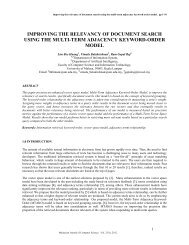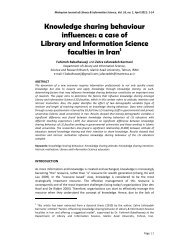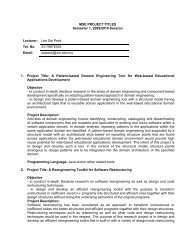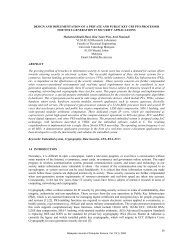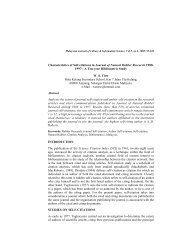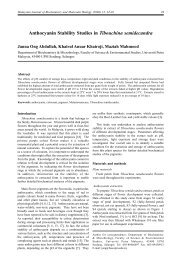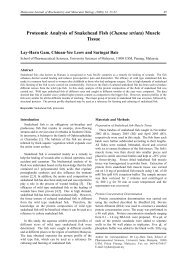Chiu, C.C.; Yeh, Y.S. & Chou, J.S.This assumption is true if the reliability of any path between X and K is lessthan that of links between the set K of nodes. Restated, the proposed method canbe used to achieve maximum reliability.In each set of nodes, if the number of members of a set is |K|, the followingequation can be used to compute its weightw(G k ) = { [w( E Gk) + w(ε s, j)] / [|K| × (|K|-1)/2] + w( V Gk) / [(n-1) × |K|] },(4)wherew( E Gk)= Σw ( e i , j) and e i,j ∈a set E Gkof direct links between any two nodes inG kw( V Gk)= Σw( v j) and v j ∈a set V of nodes in G G kk.According to w( E Gk) and w( V Gk) in Eq. (4), only the sum of the weight of thelinks between v i and G k and the weight of node v i should be derived. Therefore,the weight of the K-terminal with another node, say v i , can be obtained easilyand efficiently using the equation as follows:w(G k Υ {v i }) = { [w( E Gk) + w( ε s, j) + Σw ( e i , j)vj ∈V G k, vi∉V G k, ei , j ∉EG k+[w( V Gk)+w(v i )] / [(n-1) × (|K|+1)] }. (5)] / [((|K|+1) × |K|)/2]Herein, a node of the heaviest weight is selected and serves as the starting nodefor deriving an adequate K-terminal. Before assigning one node to a selected set,the proposed algorithm only inspects those nodes that are adjacent to any nodeof the selected node for the reason of reducing computation time. In the firstnode assigned to a selected set, the proposed algorithm also probes nodes inV . The notation V represents a set of nodes which ε ε( Gk ) ε( G k ) s, jexist in G k.The Proposed Heuristic AlgorithmWe present a heuristic algorithm by carefully selecting the starting node v saccording to a node’s weight. Before assigning a node to the selected set, theproposed algorithm probes those nodes V adj(Gk) that are adjacent to any node of aselected node except for the selected nodes. After obtaining the K-terminal,108
Effective Algorithm for Optimal K-Terminal Reliability of Distributed SystemSYREL (Hariri and Raghavendra, 1987) is applied to compute the reliability.The proposed heuristic algorithm is to maximize K-terminal reliability of a DS.The detailed steps for KTR are described in Appendix 1.ILLUSTRATIVE EXAMPLESExample 1Figure 2 illustrates the topology of a DS with eight nodes and eleven links. Theproblem involves determining a subset, K-terminal, of the DS which includessome of the nodes v 1 , v 2 , …, v 8 whose reliability is maximal.Fig. 2. The DS with eight nodes and eleven links.v 2 v 3 v 4e2,3 e 3,4p 1,2 =0.89 p 1,7 =0.81e 4,5 p 1,8 =0.93 p 2,3 =0.85v 1 e 1,2 v 8 e 4,8 v 5 p 3,4 =0.91 p 4,5 =0.82ee 4,6 1,8p 4,6 =0.83 p 4,8 =0.96e 1,7 e 6,8 p 5,6 =0.87 p 6,7 =0.84e 5,6 p 6,8 =0.88e 6,7v 7 v 6In Step 1, each node’s weight is evaluated using Eq. (1). The weight of v 1 ,v 2 , …, and v 8 are 0.998537, 0.9835, 0.9865, 0.9998898, 0.9766, 0.9995756,0.9696 and 0.999664, respectively. Therefore, v 4 is the node with maximalweight and is served as starting node for obtaining an adequate K-terminal.Notably, G k is {v 4 }.In Step 2, because ε s, j does not exist, set Eε( Gk )to empty.In Step 3, each link’s weight is evaluated using Eq. (2).In Step 4, let V tmp = V = ∅ , w V ε( Gk )(G k) = w(v s ), w( E Gk) = 0.109



